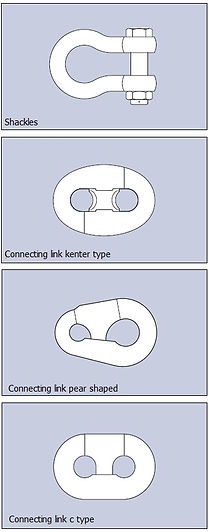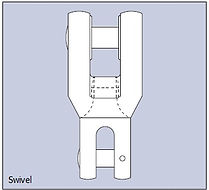Connector Types
Shackles
The shackle is a connector that is very common in the offshore industry. It consists of a bow, which is closed by a pin. Many different types of shackles are available, dempending on the application. The shackle can be used in both temporary and permanent moorings.
Connecting link kenter type
The connecting link kenter type is most commonly used for the connection of two pieces of chain mooring line, where the terminations of the two pieces have the same dimensions. The connecting link kenter type has the same outside length as a chain link of the same diameter. Gernerally connecting links kenter type are not used in permanent mooring systems, as the have a shorter fatigue life than the chain.
Connecting link pear shaped
The pear shaped connecting link is a similar to the connecting link kenter type, except that is is used for the connection of two pieces of mooring linke with terminations that have different dimensions. Like the connecting link kenter type, the pear shaped connecting links are not used in permanent mooring systems.
Connecting link C type
Like the connecting link kenter type, the connecting link C type is used for the connection of two pieces of mooring line with terminations that have the same dimensions. The major difference between the kenter type and the c type is the way that the connector is opened and closed. This connector is gernerally not used in permanent moorings.
Swivels
A swivel is used in a mooring system, generally of a temporary type, to relieve the twist and torque that builds up in the mooring line. The swivel is often placed a few links from the anchor point, although it can also be placed between a section of chain and a section of wire rope. There are many different types of swivels available, altough a disadvantage of most common swivels is that they may not function while under load, which is caused by high friction inside the turning mechanism. A new development is swivels that are capable of swiveling under load, due to special bearing surfaces inside the mechanism.


